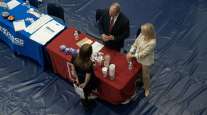US Unemployment Claims Hit 6.6 Million, Competition Mounts for Masks

[Stay on top of transportation news: Get TTNews in your inbox.]
The economic damage from the coronavirus crisis piled up as an unprecedented 6.6 million Americans filed for unemployment benefits in a single week, and the competition for masks and other protective gear intensified amid growing evidence that people who are infected but have no symptoms can spread the virus.
The staggering new unemployment claims, announced April 2, double those of last week’s previous record high and bring to 10 million the number of people who have lost their jobs in the U.S. in just two weeks because of the outbreak.
They almost certainly signal the onset of a severe global recession.
With large portions of America under lockdown to try to contain the scourge, job losses for the world’s biggest economy could reach as high as 20 million and the unemployment rate could spike to as high as 15% by the end of the month, many economists have said.
Meanwhile, the mounting economic fallout came amid a worldwide race to protect people against unwitting coronavirus carriers.

A study by researchers in Singapore on April 1 estimated that 10% of new infections may be sparked by people who carry the virus but have not yet developed symptoms.
In response, the U.S. Centers for Disease Control and Prevention changed how it defines the risks of infection, saying essentially that anyone may be a carrier, with or without symptoms. But neither it nor the World Health Organization changed its stance that most people do not need to wear masks.
Still, Los Angeles Mayor Eric Garcetti recommended the city’s 4 million people wear masks, saying even a “tucked-in bandanna” could slow the spread of the virus and remind people to keep their distance from each other.
“I know it will look surreal,” he said, donning a mask. “We’re going to have to get used to seeing each other like this.”
The U.S. government’s top infectious-disease official, Dr. Anthony Fauci, said medical experts are no closer to figuring out why some seemingly healthy people infected by the virus develop only mild or no symptoms while others become very sick. Fauci said April 2 on NBC’s “Today” show that he has been “puzzled from the beginning” of the epidemic.
Governments also faced off over precious protective gear. A top health official in France’s hard-hit eastern region said American officials swooped in at a Chinese airport to spirit away a planeload of masks that France had ordered.
“On the tarmac, the Americans arrive, take out cash and pay three or four times more for our orders, so we really have to fight,” Dr. Jean Rottner, an emergency room doctor in Mulhouse, told RTL radio.
Nine leading European university hospitals warned April 2 they will run out of essential medicines for COVID-19 patients in intensive care in less than two weeks. The European University Hospital Alliance said countries should cooperate, not compete, to ensure a steady supply.
President Donald Trump acknowledged that the federal stockpile is nearly depleted of the protective equipment needed by doctors and nurses.
“We’re going to have a couple of weeks, starting pretty much now, but especially a few days from now, that are going to be horrific,” he said.
In Japan, where masks are a household staple, the government planned to mail two gauze masks each to the country’s 50 million households.
Altogether, close to 1 million people around the world have contracted the virus and more than 48,000 have died, according to Johns Hopkins University. More than 200,000 have recovered.
Spain reported a record number of daily virus-related deaths, 950 in 24 hours, bringing its total deaths to about 10,000, despite signs that the infection rate is slowing. Italy had the most virus deaths in the world at over 13,000,
Over 200,000 people have been infected in the U.S., and the death toll climbed past 5,100.
“How does it end? And people want answers,” New York Gov. Andrew Cuomo said in the state that become the worst hot spot in the nation. “I want answers. The answer is nobody knows for sure.”
Cuomo said projections suggest the crisis in New York will peak at the end of April, with a high death rate continuing through July.
New York state’s coronavirus death toll doubled in 72 hours to more than 1,900 on April 1. Cuomo has complained that states are competing against each other for protective gear and breathing machines, or being outbid by the federal government, in a competition he likened to being on eBay.
In Greece, authorities placed an entire refugee camp of 2,400 people under quarantine after discovering that one-third of the 63 contacts of just one infected woman tested positive — and none had showed symptoms.
The real figures are believed to be much higher because of testing shortages, differences in counting the dead and mild cases that have gone unreported. Critics also say some governments have been deliberately under-reporting cases in order to avoid criticism.
Frank Ulrich Montgomery, chairman of the World Medical Association, called China’s recent low figures on infections “nonsense” but added that many countries are working with uncertain data.
For most people, the coronavirus causes mild or moderate symptoms, such as fever and cough. But for others, especially older adults and people with health problems, it can cause severe symptoms like pneumonia.
People in Wuhan, the Chinese city that was once the epicenter of the crisis, are starting to return to work, tracked by a color-coded smartphone app that shows if they are free of symptoms.
Green means the user is symptom-free; it is required to board a subway, check into a hotel or enter the city of 11 million. Serious travel restrictions still exist for those who have yellow or red symbols.
Michael R. Sisak, Lori Hinnant and Mark Sherman contributed to this report.
Want more news? Listen to today's daily briefing:




